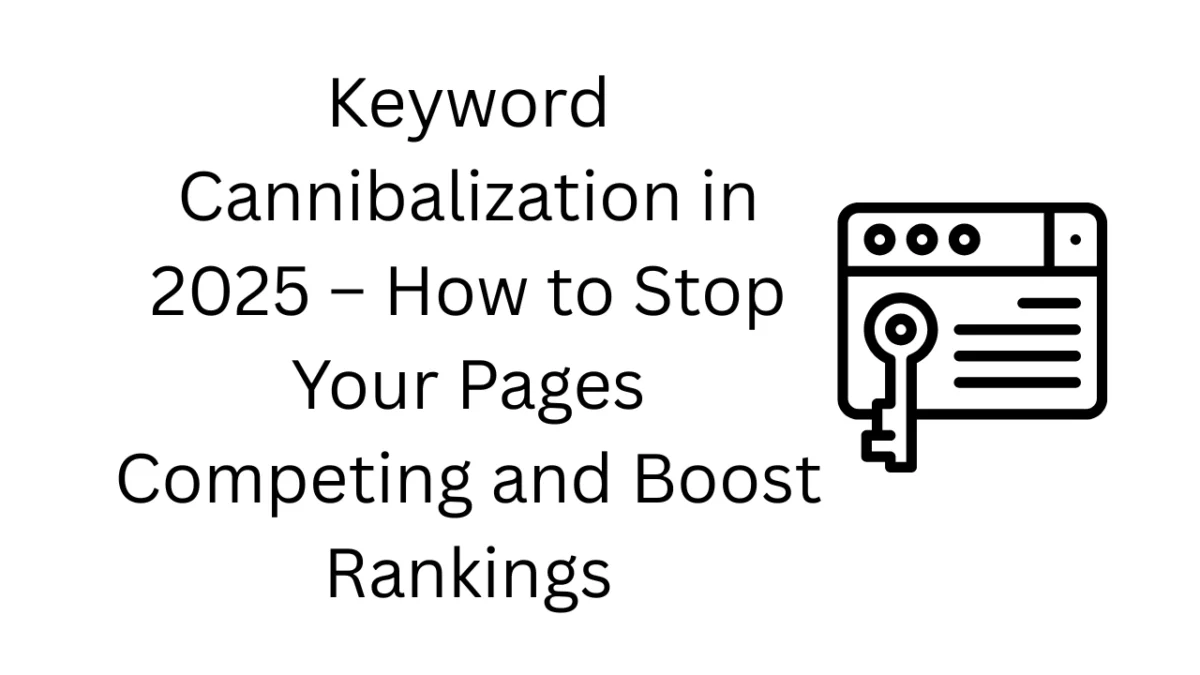Search marketers have been haunted by the phrase keyword cannibalization for years. It conjures up the image of your own content fighting itself—pages battling for the same keyword, rankings slipping through the cracks. But according to Google’s own search advocate John Mueller, the story is far more nuanced.

This comprehensive guide explains what keyword cannibalization really is (and isn’t), how Google views it in 2025, and what practical steps you can take to strengthen your site’s authority. Whether you run a single niche blog or manage hundreds of ecommerce pages, these insights will help you build a clean, search-friendly content strategy.
Understanding Keyword Cannibalization
Traditionally, keyword cannibalization is described as a situation where multiple pages on the same site target the same keyword. The fear is that Google becomes confused and splits ranking signals across those pages, causing all of them to perform poorly.
The term makes sense metaphorically—your pages supposedly “eat” each other’s chances to rank. Yet Google’s latest comments challenge this dramatic narrative.
Google’s Updated Perspective
In a recent Q&A highlighted by Search Engine Journal, John Mueller clarified that simply having more than one page rank for the same query is not inherently a problem. If Google shows two of your pages for one keyword, it often means both are relevant and valuable.
Mueller emphasized that the phrase “keyword cannibalization” is vague and often misused. It can hide the real issues: duplicate content, weak internal linking, thin content, or a poorly structured site. Rather than blaming cannibalization, he suggests investigating the actual cause of performance issues.
Read Also: The Future of Search: How AI Summaries Are Changing the Internet Forever
When Overlap Becomes Harmful
While the scary label might be overblown, certain patterns still hurt rankings and user experience:
- Near-duplicate content: Pages that repeat the same information with minimal differences.
- Thin or unfocused content: Articles that stray off topic or offer little unique value.
- Poor internal linking: Links that fail to guide users and search engines toward the most authoritative page on a topic.
These are not problems because of the term “cannibalization,” but because they reduce the clarity and usefulness of your website.
Why Users Should Care
From a user’s perspective, encountering several similar pages can be confusing. If visitors cannot easily tell which page offers the most complete answer, they may bounce. Lower engagement and higher bounce rates send negative signals to search engines, indirectly impacting rankings.
Practical Steps to Fix True Issues
1. Audit Your Content
Create a spreadsheet of your main pages, target keywords, and search rankings. Identify where two or more pages target the same intent. Pay special attention to pages with low impressions or stagnant traffic.
2. Consolidate Similar Pages
If two pages essentially say the same thing, merge them into one stronger resource. Redirect the weaker page to the stronger one using a 301 redirect. This passes link equity and prevents confusion.
3. Refocus Supporting Pages
When pages partially overlap, adjust one to cover a narrower subtopic. For example, if you have “Best Budget Laptops” and “Best Laptops Under $500,” make sure each targets a distinct audience.
4. Strengthen Internal Linking
Point relevant internal links toward the primary page for a topic. This signals to Google which page is the main authority. Use descriptive anchor text so users and search engines understand the relationship.
5. Use Canonical Tags if Needed
When you need to keep both pages for business reasons, a canonical tag tells search engines which page is the preferred version.
6. Improve Content Depth
Thin pages often perform poorly because they lack unique insights. Add research, examples, visuals, or data that set your content apart.
Key Notes for Quick Reference
- Multiple pages ranking for the same keyword is not automatically harmful.
- “Keyword cannibalization” is an overused label that often hides deeper issues.
- Focus on user experience, not just search algorithms.
- Consolidate or refocus pages only when they genuinely overlap in intent.
- Use 301 redirects or canonical tags to guide search engines when merging is necessary.
- Strong internal linking helps Google recognize the main page on a topic.
- High-quality, in-depth content naturally outperforms thin, duplicated pages.
Read Also: How to Enrich LLM Context to Significantly Enhance Capabilities
The Bigger SEO Picture in 2025
Search engines have become more sophisticated in evaluating context and intent. Instead of fixating on single keywords, Google interprets entire topics and the relationships between pages.
That means your site can safely have multiple pages around a theme—if each offers unique value. For example, a travel site might have separate pages for “Paris Travel Guide,” “Best Restaurants in Paris,” and “Paris Budget Tips.” Even though they share keywords like “Paris,” each page answers a different user need.
Myth vs. Reality
| Myth | Reality |
|---|---|
| Multiple pages for the same keyword always hurt rankings | Google often rewards multiple relevant pages if each serves a unique purpose |
| Keyword cannibalization is the root of low rankings | Low quality, duplication, or poor site structure are usually the real culprits |
| Deleting or merging pages is always the fix | Sometimes pages should remain separate; clarify intent instead |
Checklist: Your Anti-Cannibalization Plan
- Map Content: Identify pages with similar keywords and overlapping intent.
- Evaluate Intent: Determine whether each page addresses a unique user need.
- Decide Action: Merge, refocus, or leave as is based on the overlap.
- Update Links: Ensure internal links highlight the main authoritative page.
- Measure Results: Track rankings, impressions, and clicks to confirm improvements.
Final Thoughts
The phrase “keyword cannibalization” sounds dramatic, but in 2025 it’s mostly a myth. Google’s own guidance is clear: having multiple pages rank for the same keyword isn’t a penalty. The real danger lies in poor content strategy—thin articles, duplicate pages, or sloppy internal linking.
Treat the term as a signal to review your site carefully, not as a diagnosis in itself. By focusing on user experience, unique value, and clear site architecture, you’ll not only avoid confusion but also strengthen your rankings across the board.



